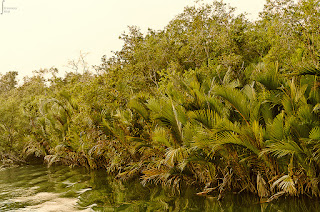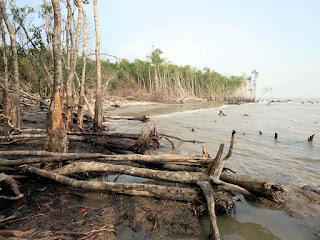Natural Beauty of Bangladesh ( About Sundarbans)
part: 4Source: Wikipedia
This article is about the Bangladeshi part.
Sundarbans
Hazards
Natural hazards
According to a report created by United Nations agency, the landfall of Cyclone Sidr broken around fortieth of Sundarbans in 2007.
Man made hazards
Further information: Rampal powerhouse and 2014 Sundarbans oil spill
In August 2010, a memoranda of Understanding was signed between People's Republic of Bangladesh Power Development Board (BPDB) and India's state-owned National Thermal Power Corporation (NTPC) wherever they selected to implement the coal-fired Rampal powerhouse by 2016. The projected project, on a section of over one,834 acres of land, is located fourteen kilometres north of the Sundarbans. This project violates the environmental impact assessment pointers for coal-based thermal power plants. Environmental activists contend that the projected location of the Rampal Station would violate provisions of the Ramsar Convention. the govt. of People's Republic of Bangladesh rejected the allegations that the coal-based powerhouse would adversely have an effect on the world's largest flowering tree forest.
On nine Gregorian calendar month 2014 associate oil-tanker named Southern Star VII, carrying 358,000 litres (79,000 imp gal; ninety five,000 U.S.A. gal) of chamber oil, was ruined within the Sela watercourse of Sundarbans once it had been hit by a ship. The oil meet 350 km2 (140 sq mi) space once the clash, as of seventeen Gregorian calendar month. The slick unfold to a second watercourse and a network of canals within the Sundarbans and blackened the boundary. The event was terribly threatening to trees, plankton, immense populations of little fishes and dolphins. The event occurred at a protected Sundarbans flowering tree space, home to rare river and Ganges dolphins. till fifteen Gregorian calendar month 2014 solely fifty,000 litres (11,000 imp gal; thirteen,000 U.S.A. gal) of oil from the world were cleansed up by native residents, {bangladesh|Bangladesh|People's Republic of People's Republic of Bangladesh|Bangla Desh|East Pakistan|Asian country|Asian nation} Navy and therefore the government of Bangladesh. Some reports indicated that the event killed some life. On thirteen Gregorian calendar month 2014, a dead {irrawaddy|Irrawaddy|Irrawaddy watercourse|river} dolphin was seen floating on the Harintana-Tembulbunia channel of the Sela River.
Economy
 |
| Sundarbans |
.
The forest has vast protecting and productive functions. Constituting fifty one of the whole reserved forest estate of People's Republic of Bangladesh, it contributes regarding forty one of total forest revenue and accounts for regarding forty five of all timber and fuel wood output of the country. variety of industries (e.g., newspaper mill, match manufacturing plant, hardboard, boat building, article of furniture making) are supported raw materials obtained from the Sundarbans system. Non-timber forest merchandise and plantations facilitate generate wide employment and financial gain opportunities for a minimum of [*fr1] 1,000,000 poor coastal individuals. It provides natural protection to life and properties of the coastal population in cyclone-prone People's Republic of Bangladesh.
Agriculture
Part of the Sunderbans is protected from recurrent event flow by levees and there one finds villages and agriculture. throughout the monsoon season, the low lying agricultural lands are wet thus the|and also the} summer crop (kharif crop) is therefore principally deepwater rice or floating rice. within the dry winter season the land is often uncropped and used for kine grazing. However, the lands close to the villages are irrigated from ponds that were stuffed up throughout monsoon, and vegetable crops (rabi crops) may be full-grown here.
Habitation
The Sundarbans contains a population of over four million however a lot of of it's largely freed from permanent human habitation. Despite human habitations and a century of economic exploitation of the forest well into the late Forties, the Sundarbans maintained a forest closure of regarding seventieth in step with the Overseas Development Administration (ODA) of the uk in 1979.
Administration
The Sundarbans space is one amongst the foremost densely inhabited within the world, and therefore the population is increasing.[citation needed] As a result, half this ecoregion's flowering tree forests are weigh down to provide fuelwood and different natural resources. Despite the extraordinary and large-scale exploitation, this still is one amongst the biggest contiguous areas of mangroves within the world. Another threat comes from deforestation and water diversion from the rivers interior, that causes much more silt to be delivered to the water, preventive up the waterways.
The board of Forest is to blame for the administration and management of Sundarban park in province. The Principal Chief Conservator of Forests (PCCF), life & Bio-Diversity & ex-officio Chief life lawman, province is that the senior most officer trying over the administration of the park. The Chief Conservator of Forests (South) & Director, Sundarban region Reserve is that the body head of the park at the native level associated is power-assisted by a Deputy Field Director and an Assistant Field Director. The park space is split into 2 ranges, overseen by vary forest officers. every vary is any sub-divided into beats. The park conjointly has floating watch stations and camps to shield the property from poachers.
The park receives help from the regime additionally because the Ministry of setting and Forests underneath numerous set up and Non-Plan Budgets. extra funding is received underneath the Project Tiger from the Central Government. In 2001, a grant of US$20,000 was received as a preparative help for promotion between India and People's Republic of Bangladesh from the planet Heritage Fund.
A new Khulna Forest Circle was created in People's Republic of Bangladesh back in 1993 to preserve the forest, and Chief Conservators of Forests are announce since. The direct body head of the Division is that the Divisional Forest Officer, based mostly at Khulna, WHO contains a range of skilled, subprofessional and support employees and provision supports for the implementation of necessary management and body activities. the fundamental unit of management is that the compartment. There are fifty five compartments in four Forest Ranges and these are clearly demarcated principally by natural options like rivers, canals and creeks.
Protection
A map of the protected areas of the Indian Sunderbans, showing the boundaries of the tiger reserve, the park and therefore the 3 life sanctuaries, conservation and lodging centres, subsistence cities, and access points. the whole wooded (dark green) space constitutes the region Reserve, with the remaining forests outside the park and life sanctuaries being given the standing of a reserve forest.
The People's Republic of Bangladesh a part of the forest lies underneath 2 forest divisions, and 4 body ranges viz Chandpai (Khulna District), Sarankhola (Khulna), and Burigoalini (Satkhira District) and has sixteen forest stations. it's any divided into cardinal compartments and 9 blocks.[8] There are 3 life sanctuaries established in 1977 underneath the People's Republic of Bangladesh life (Preservation) Order, 1973 (P.O. twenty three of 1973). The province a part of the forest lies underneath the district of South & North twenty four Parganas.
Protected areas cowl fifteenth of the Sundarbans mangroves as well as Sundarbans park and Sajnakhali life Sanctuary, in province, Sundarbans East, Sundarbans South and Sundarbans West life Sanctuaries in People's Republic of Bangladesh.
Sundarban park
Main article: Sundarbans park
The Sundarban park may be a park, Tiger Reserve, and a region Reserve in province, India. it's a part of the Sundarbans on the Ganges Delta, and adjacent to the Sundarbans Reserve Forest in People's Republic of Bangladesh. The delta is densely lined by flowering tree forests, and is one amongst the biggest reserves for the Bengal tiger. it's conjointly home to a spread of bird, reptilian and invertebrate species, as well as the salt-water crocodilian reptile. this Sundarbans park was declared because the core space of Sundarbans Tiger Reserve in 1973 and a life sanctuary in 1977. On four could 1984 it absolutely was declared a park.
Sundarbans West life Sanctuary
Main article: Sundarbans West life Sanctuary
Sundarbans West life Sanctuary may be a United Nations agency World Heritage web site. The region supports mangroves, including: thin stands of Gewa (Excoecaria agallocha) and dense stands of Goran (Ceriops tagal), with discontinuous patches of Hantal palm (Phoenix paludosa) on drier ground, watercourse banks and levees. The fauna of the sanctuary is extremely various with some forty species of mammals, 260 species of birds and thirty five species of reptiles. the best of those being the Bengal tiger of that associate calculable 350 stay within the People's Republic of Bangladesh Sundarbans. different massive mammals are boar, chital horin (spotted deer), Indian otter and catarrhine monkey. 5 species of marine turtles frequent the coastal zone and 2 vulnerable reptiles are gift – the estuarial crocodilian reptile and therefore the python.
Sundarbans East life Sanctuary
Main article: Sundarbans East life Sanctuary
Sundarbans East life Sanctuary extends over a section of thirty one,227 hectares (77,160 acres). Sundari trees (Heritiera fomes) dominate the flora, interspersed with Gewa (Excoecaria agallocha) and Passur (Xylocarpus mekongensis) with Kankra (Bruguiera gymnorhiza) occurring in areas subject to a lot of frequent flooding. there's associate understory of Shingra (Cynometra ramiflora) wherever, soils are drier and Heilong Jiang (Aglaia cucullata) in wetter areas and Goran (Ceriops decandra) in additional saline places. liliopsid genus palm (Nypa fruticans) is widespread on emptying lines.
Sundarbans South life Sanctuary
Main article: Sundarbans South life Sanctuary
Sundarbans South life Sanctuary extends over a section of thirty six,970 hectares (91,400 acres). there's obviously the best seasonal variation in salinity levels and probably represents a section of comparatively longer period of moderate salinity wherever Gewa (Excoecaria agallocha) is that the dominant woody species. it's usually mixed with Sundri, that is ready to displace in circumstances like unnaturally opened canopies wherever Sundri doesn't regenerate as effectively. it's conjointly ofttimes related to a dense understory of Goran (Ceriops tagal) and generally Passur.
Sajnakhali life Sanctuary
Main article: Sajnakhali life Sanctuary
Sajnakhali life Sanctuary may be a 362-square-kilometre (140 sq mi) space within the northern a part of the Sundarbans delta in South twenty four Parganas district, province, India. the world is principally flowering tree scrub, forest and swamp. it absolutely was founded as a sanctuary in 1976. it's home to a chic population of various species of life, like water fowl, heron, pelican, noticed ruminant, macaque macaques, wild boar, tigers, water monitor lizards, fishing cats, otters, ridley turtles, crocodiles, batagur terrapins, and migratory birds.
In well-liked culture
The Sundarbans is well known through various Bengali folks songs and dances, usually centred round the folks heroes, gods and goddesses specific to the Sunderbans (like Bonbibi and Dakshin Rai) and to the Lower Gangetic Delta (like Manasa and Chand Sadagar). The Bengali folks epic Manasamangal mentions Netidhopani and has some passages set within the Sundarbans throughout the heroine Behula's quest to bring her husband Lakhindar back to life.
The area provides the setting for many novels by Emilio Salgari, (e.g. The Mystery of the Black Jungle). Sundarbaney Arjan Sardar, a unique by Shibshankar Mitra, and Padma Nadir Majhi, a unique by Manik Bandopadhyay, are supported the trials of lives of villagers and fishermen living within the Sunderbans region, and are woven into the Bengali psyche to a good extent. a part of the plot of Salman Rushdie's booking agent Prize winning novel, Midnight's youngsters is ready within the Sundarbans. This forest is adopted because the setting of Kunal Basu's story "The Japanese Wife" and therefore the succeeding film adaptation. Most of the plot of associate internationally acclaimed author, Amitav Ghosh's 2004 novel, The Hungry Tide, is ready within the Sundarbans. The plot centres on a wilful yankee cetologist WHO arrives to check a rare species of dolphin, recruitment a neighborhood trained worker and translator to help her. The book conjointly mentions 2 accounts of the Bonbibi story of "Dukhey's Redemption". Manik Bandopadhyay's Padma Nadir Majhi was created into a pic by Goutam Ghose.
The Sunderbans has been the topic of a close and well-researched profound work on Bonbibi (a 'forest goddess' commemorated by Hindus), on the relation between the islanders and tigers and on conservation and the way it's perceived by the inhabitants of the Sundarbans,[68] additionally as various non-fiction books, as well as The Man-Eating Tigers of Sundarbans by Sy Montegomery for a young audience, that was shortlisted for the Dorothy patience Fisher Children's Book Award. In Up The Country, Emily Eden discusses her travels through the Sunderbans. various documentary movies are created regarding the Sunderbans, as well as the 2003 IMAX production Shining Bright regarding the Bengal tiger. The acclaimed BBC TV series Ganges documents the lives of villagers, particularly honey collectors, within the Sundarbans.
















